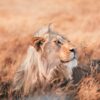The Lower Kalahari region in South Africa is a fascinating destination for hunting enthusiasts. This expansive, arid landscape offers unique opportunities to experience the thrill of hunting in one of the world’s most iconic deserts.
In this blog post, we’ll delve into the rich history of hunting in the Lower Kalahari, explore the diverse wildlife, and provide practical tips for planning your hunting adventure in this remarkable part of South Africa.
A Brief History of Hunting in the Kalahari
Hunting has been an integral part of the Kalahari region’s history for thousands of years. The indigenous San people, also known as Bushmen, have been hunting in this area for millennia. Using traditional methods and tools such as bows and arrows, traps, and snares, the San people developed a deep understanding of the land and its wildlife. Their sustainable hunting practices ensured that the delicate balance of the Kalahari ecosystem was maintained.
In the modern era, hunting in the Lower Kalahari has evolved into a regulated activity aimed at conservation and sustainable use of wildlife resources. Game reserves and hunting concessions have been established, providing hunters with opportunities to pursue game while contributing to the preservation of the region’s natural heritage.
Wildlife in the Lower Kalahari
The Lower Kalahari is home to a diverse array of wildlife, making it a prime destination for hunters. Some of the most sought-after species include:
- Gemsbok (Oryx gazella): Known for their striking appearance and impressive horns, gemsbok are a popular target for hunters. These antelopes are well-adapted to the arid conditions of the Kalahari and are often found in open grasslands and sand dunes.
- Springbok (Antidorcas marsupialis): The national animal of South Africa, the springbok is a small, agile antelope renowned for its incredible speed and leaping ability. Hunting springbok requires skill and patience, as these animals are highly alert and quick to flee.
- Kudu (Tragelaphus strepsiceros): With their majestic spiral horns, kudu is one of the most iconic antelope species in Africa. They inhabit the bushveld and woodland areas of the Kalahari, often requiring hunters to navigate dense vegetation to track them down.
- Warthog (Phacochoerus africanus): Recognizable by their distinctive tusks and facial warts, warthogs are a challenging and rewarding quarry for hunters. These animals are typically found near water sources and in areas with ample vegetation for foraging.
Planning Your Hunting Adventure
To make the most of your hunting trip to the Lower Kalahari, careful planning is essential. Here are some key considerations to keep in mind:
Choosing the Right Time of Year
The Kalahari has a harsh climate with extreme temperatures, so timing your visit is crucial. The best time for hunting is during the cooler months, from May to September. During this period, temperatures are more manageable, and wildlife is more active, increasing your chances of a successful hunt.
Selecting a Reputable Outfitter
Partnering with a reputable hunting outfitter is essential for a safe and successful experience. Look for outfitters with extensive knowledge of the area, experienced guides, and a commitment to ethical hunting practices. They can assist with obtaining necessary permits, organizing accommodations, and ensuring you have the right equipment.
Understanding Hunting Regulations
South Africa has strict regulations governing hunting activities to ensure the sustainability of wildlife populations. Familiarize yourself with the local hunting laws, including bag limits, species-specific restrictions, and licensing requirements. Your outfitter should provide guidance on compliance with these regulations.
Preparing Physically and Mentally
Hunting in the Kalahari can be physically demanding, requiring long hours of walking and stalking in challenging terrain. Physical fitness and stamina are crucial. Additionally, mental preparation is important, as hunting often involves periods of patience and perseverance.
The Hunting Experience
Embarking on a hunting expedition in the Lower Kalahari is an adventure like no other. The experience combines the thrill of the chase with the serene beauty of the desert landscape. Here’s a glimpse into what you can expect:
Tracking and Stalking
Tracking and stalking game in the Kalahari requires skill and keen observation. Experienced guides will teach you how to read animal tracks, identify signs of wildlife, and move stealthily through the terrain. The vast, open landscapes of the Kalahari offer unique challenges and rewards, as you navigate dunes, dry riverbeds, and sparse vegetation in pursuit of your quarry.
The Role of Conservation
Modern hunting practices in the Kalahari are closely tied to conservation efforts. Revenue generated from hunting permits and fees is often reinvested into wildlife management and habitat preservation. By participating in regulated hunting, you contribute to the sustainable management of the region’s natural resources, ensuring that future generations can enjoy this unique environment.
Ethical Hunting Practices
Ethical hunting is paramount in the Kalahari. This includes adhering to fair chase principles, respecting animal welfare, and minimizing environmental impact. Ethical hunters prioritize clean, humane kills and strive to utilize as many of the harvested animals as possible, reducing waste and honouring the life taken.
Embracing the Kalahari Experience
Beyond the thrill of the hunt, the Lower Kalahari offers a rich cultural and natural experience. Take time to immerse yourself in the local culture, learn about the traditions of the San people, and appreciate the stunning landscapes that define this remarkable region. Consider extending your stay to explore nearby attractions such as the Kgalagadi Transfrontier Park, where you can witness the incredible biodiversity and natural beauty of the Kalahari.
Conclusion
Hunting in the Lower Kalahari of South Africa is a unique and rewarding experience that combines the excitement of pursuing game with the responsibility of conservation. By understanding the region’s history, wildlife, and ethical hunting practices, you can embark on an adventure that not only fulfills your hunting aspirations but also contributes to the preservation of this extraordinary environment. Whether you are an experienced hunter or a novice seeking a new challenge, the Lower Kalahari promises an unforgettable journey into the heart of one of Africa’s most captivating landscapes.
FAQs
What is the best time of year for hunting in the Lower Kalahari?
The best time for hunting is during the cooler months, from May to September, when temperatures are more manageable and wildlife is more active.
What are some of the most sought-after species in the Lower Kalahari?
Some of the most sought-after species include gemsbok, springbok, kudu, and warthog.
Why is ethical hunting important in the Kalahari?
Ethical hunting ensures fair chase, respects animal welfare, minimizes environmental impact, and supports conservation efforts through regulated practices.
How can I choose a reputable hunting outfitter?
Look for outfitters with extensive local knowledge, experienced guides, and a commitment to ethical hunting practices. They should also assist with permits, accommodations, and equipment.
What should I consider when planning a hunting trip to the Lower Kalahari?
Consider the timing of your visit, choose a reputable outfitter, understand hunting regulations, and prepare physically and mentally for the demanding terrain.
Can hunting in the Kalahari contribute to conservation?
Yes, revenue from hunting permits and fees is often reinvested into wildlife management and habitat preservation, supporting the sustainable management of natural resources.


















Leave a Comment
You must be logged in to post a comment.